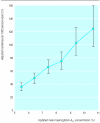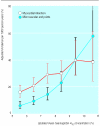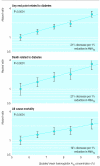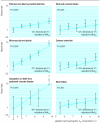Association of glycaemia with macrovascular and microvascular complications of type 2 diabetes (UKPDS 35): prospective observational study - PubMed (original) (raw)
Association of glycaemia with macrovascular and microvascular complications of type 2 diabetes (UKPDS 35): prospective observational study
I M Stratton et al. BMJ. 2000.
Abstract
Objective: To determine the relation between exposure to glycaemia over time and the risk of macrovascular or microvascular complications in patients with type 2 diabetes.
Design: Prospective observational study.
Setting: 23 hospital based clinics in England, Scotland, and Northern Ireland.
Participants: 4585 white, Asian Indian, and Afro-Caribbean UKPDS patients, whether randomised or not to treatment, were included in analyses of incidence; of these, 3642 were included in analyses of relative risk.
Outcome measures: Primary predefined aggregate clinical outcomes: any end point or deaths related to diabetes and all cause mortality. Secondary aggregate outcomes: myocardial infarction, stroke, amputation (including death from peripheral vascular disease), and microvascular disease (predominantly retinal photo-coagulation). Single end points: non-fatal heart failure and cataract extraction. Risk reduction associated with a 1% reduction in updated mean HbA(1c) adjusted for possible confounders at diagnosis of diabetes.
Results: The incidence of clinical complications was significantly associated with glycaemia. Each 1% reduction in updated mean HbA(1c) was associated with reductions in risk of 21% for any end point related to diabetes (95% confidence interval 17% to 24%, P<0.0001), 21% for deaths related to diabetes (15% to 27%, P<0.0001), 14% for myocardial infarction (8% to 21%, P<0.0001), and 37% for microvascular complications (33% to 41%, P<0.0001). No threshold of risk was observed for any end point.
Conclusions: In patients with type 2 diabetes the risk of diabetic complications was strongly associated with previous hyperglycaemia. Any reduction in HbA(1c) is likely to reduce the risk of complications, with the lowest risk being in those with HbA(1c) values in the normal range (<6.0%).
Figures
Figure 1
Incidence rate and 95% confidence intervals for any end point related to diabetes by category of updated mean haemoglobin A1c concentration, adjusted for age, sex, and ethnic group, expressed for white men aged 50-54 years at diagnosis and with mean duration of diabetes of 10 years
Figure 2
Incidence rates and 95% confidence intervals for myocardial infarction and microvascular complications by category of updated mean haemoglobin A1c concentration, adjusted for age, sex, and ethnic group, expressed for white men aged 50-54 years at diagnosis and with mean duration of diabetes of 10 years
Figure 3
Hazard ratios, with 95% confidence intervals as floating absolute risks, as estimate of association between category of updated mean haemoglobin A1c concentration and any end point or deaths related to diabetes and all cause mortality. Reference category (hazard ratio 1.0) is haemoglobin A1c <6% with log linear scales. P value reflects contribution of glycaemia to multivariate model. Data adjusted for age at diagnosis of diabetes, sex, ethnic group, smoking, presence of albuminuria, systolic blood pressure, high and low density lipoprotein cholesterol, and triglycerides
Figure 4
Hazard ratios, with 95% confidence intervals as floating absolute risks, as estimate of association between category of updated mean haemoglobin A1c concentration and myocardial infarction, stroke, microvascular end points, cataract extraction, lower extremity amputation or fatal peripheral vascular disease, and heart failure. Reference category (hazard ratio 1.0) is haemoglobin A1c <6% with log linear scales. P value reflects contribution of glycaemia to multivariate model. Data adjusted for age at diagnosis of diabetes, sex, ethnic group, smoking, presence of albuminuria, systolic blood pressure, high and low density lipoprotein cholesterol, and triglycerides
Comment in
- Controlling glucose and blood pressure in type 2 diabetes.
Tuomilehto J. Tuomilehto J. BMJ. 2000 Aug 12;321(7258):394-5. doi: 10.1136/bmj.321.7258.394. BMJ. 2000. PMID: 10938030 Free PMC article. No abstract available. - Glycaemia and vascular effects of type 2 diabetes. Lowering glucose concentrations may not be of any value in itself.
Budenholzer B. Budenholzer B. BMJ. 2001 May 19;322(7296):1245-6; author reply 1247. BMJ. 2001. PMID: 11388182 Free PMC article. No abstract available. - Glycaemia and vascular effects of type 2 diabetes. UKPDS is not a cohort study and analysis is misleading.
Cruickshank JK. Cruickshank JK. BMJ. 2001 May 19;322(7296):1246; author reply 1247. BMJ. 2001. PMID: 11388184 No abstract available. - Very tight glucose control: May be high risk, low benefit.
Yudkin JS. Yudkin JS. BMJ. 2008 Mar 29;336(7646):683. doi: 10.1136/bmj.39520.531319.3A. BMJ. 2008. PMID: 18369208 Free PMC article. No abstract available.
Similar articles
- Association of systolic blood pressure with macrovascular and microvascular complications of type 2 diabetes (UKPDS 36): prospective observational study.
Adler AI, Stratton IM, Neil HA, Yudkin JS, Matthews DR, Cull CA, Wright AD, Turner RC, Holman RR. Adler AI, et al. BMJ. 2000 Aug 12;321(7258):412-9. doi: 10.1136/bmj.321.7258.412. BMJ. 2000. PMID: 10938049 Free PMC article. - Risk factors for myocardial infarction case fatality and stroke case fatality in type 2 diabetes: UKPDS 66.
Stevens RJ, Coleman RL, Adler AI, Stratton IM, Matthews DR, Holman RR. Stevens RJ, et al. Diabetes Care. 2004 Jan;27(1):201-7. doi: 10.2337/diacare.27.1.201. Diabetes Care. 2004. PMID: 14693990 - Additive effects of glycaemia and blood pressure exposure on risk of complications in type 2 diabetes: a prospective observational study (UKPDS 75).
Stratton IM, Cull CA, Adler AI, Matthews DR, Neil HA, Holman RR. Stratton IM, et al. Diabetologia. 2006 Aug;49(8):1761-9. doi: 10.1007/s00125-006-0297-1. Epub 2006 May 31. Diabetologia. 2006. PMID: 16736131 Clinical Trial. - Association between glycated haemoglobin and the risk of congestive heart failure in diabetes mellitus: systematic review and meta-analysis.
Erqou S, Lee CT, Suffoletto M, Echouffo-Tcheugui JB, de Boer RA, van Melle JP, Adler AI. Erqou S, et al. Eur J Heart Fail. 2013 Feb;15(2):185-93. doi: 10.1093/eurjhf/hfs156. Epub 2012 Oct 25. Eur J Heart Fail. 2013. PMID: 23099356 Review. - Effect of intensive glucose lowering treatment on all cause mortality, cardiovascular death, and microvascular events in type 2 diabetes: meta-analysis of randomised controlled trials.
Boussageon R, Bejan-Angoulvant T, Saadatian-Elahi M, Lafont S, Bergeonneau C, Kassaï B, Erpeldinger S, Wright JM, Gueyffier F, Cornu C. Boussageon R, et al. BMJ. 2011 Jul 26;343:d4169. doi: 10.1136/bmj.d4169. BMJ. 2011. PMID: 21791495 Free PMC article. Review.
Cited by
- Glucagon-like Peptide-1 Receptor Agonists in the Context of Pathophysiology of Diverse Heart Failure with Preserved Ejection Fraction Phenotypes: Potential Benefits and Mechanisms of Action.
Bykova A, Serova M, Chashkina M, Kosharnaya R, Salpagarova Z, Andreev D, Giverts I. Bykova A, et al. Card Fail Rev. 2024 Oct 16;10:e14. doi: 10.15420/cfr.2024.06. eCollection 2024. Card Fail Rev. 2024. PMID: 39507374 Free PMC article. Review. - Effect of Preoperative Level of Glycemic Control with Pulsed Radiofrequency on the Incidence of Postherpetic Neuralgia in Patients with Herpes Zoster Combined with Type 2 Diabetes Mellitus: A Cohort Study.
Hua B, An M, Chen L, Ni H, Ni C, Yao M. Hua B, et al. Diabetes Metab Syndr Obes. 2024 Oct 24;17:3975-3987. doi: 10.2147/DMSO.S484193. eCollection 2024. Diabetes Metab Syndr Obes. 2024. PMID: 39469301 Free PMC article. - One-year outcomes of a digital twin intervention for type 2 diabetes: a retrospective real-world study.
Shamanna P, Erukulapati RS, Shukla A, Shah L, Willis B, Thajudeen M, Kovil R, Baxi R, Wali M, Damodharan S, Joshi S. Shamanna P, et al. Sci Rep. 2024 Oct 26;14(1):25478. doi: 10.1038/s41598-024-76584-7. Sci Rep. 2024. PMID: 39461977 Free PMC article. - Altered RBC deformability in diabetes: clinical characteristics and RBC pathophysiology.
Ebenuwa I, Violet PC, Tu H, Lee C, Munyan N, Wang Y, Niyyati M, Patra K, Wilkins KJ, Parrow N, Levine M. Ebenuwa I, et al. Cardiovasc Diabetol. 2024 Oct 18;23(1):370. doi: 10.1186/s12933-024-02453-2. Cardiovasc Diabetol. 2024. PMID: 39425096 Free PMC article.
References
- UKPDS Group. Intensive blood glucose control with sulphonylureas or insulin compared with conventional treatment and risk of complications in patients with type 2 diabetes (UKPDS 33) Lancet. 1998;352:837–853. - PubMed
- Klein R. Hyperglycemia and microvascular and macrovascular disease in diabetes. Diabetes Care. 1995;18:258–268. - PubMed
- Pirart J. Diabetes mellitus and its degenerative complications: a prospective study of 4,400 patients observed between 1947 and 1973 (part 1) Diabetes Care. 1978;1:168–188.
- Adler AI, Boyko EJ, Ahroni AJ, Stensel V, Forsberg RC, Smith DG. Risk factors for diabetic peripheral sensory neuropathy. Results of the Seattle prospective diabetic foot study. Diabetes Care. 1997;20:1162–1167. - PubMed
Publication types
MeSH terms
Substances
LinkOut - more resources
Full Text Sources
Other Literature Sources
Medical
Miscellaneous



